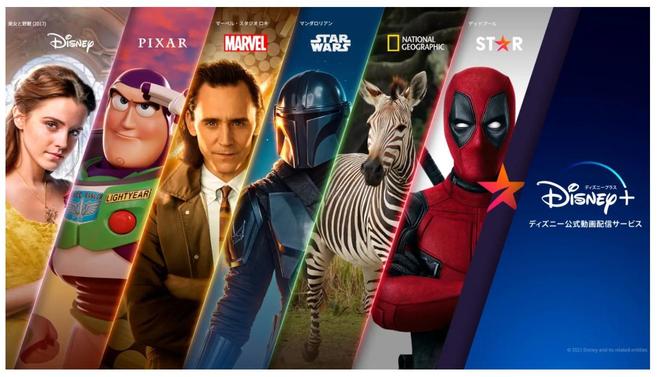With the growth of Internet video distribution services and the start of simultaneous Internet distribution of TV programs, the boundary between broadcasting and communication is disappearing, and the market environment of the broadcasting and media industry is also changing drastically. At the same time, the form of people's media contact is changing. Home TV remote controls have become a must-have for YouTube and Netflix buttons, and TV shows are no longer the only thing you can watch on your TV screen. In addition, an increasing number of people are watching overlooked videos and TVs on smart devices such as smartphones (hereinafter referred to as "smartphones") and tablets. Especially for young people, the contact time with smartphones is longer, and conversely, the contact time with TVs is decreasing.
Also, it is fresh in my memory that domestic Internet advertising expenses exceeded TV advertising expenses for the first time in 2019. From this, it can be seen that the market environment of the broadcasting and media industry in Japan is changing drastically.
This article touches on changes in people's media contact times and the status of growing Internet video distribution services, and considers the impact of the rushing Internet waves on the broadcasting and media industries.
Internet advertising costs that exceed TV advertising costs
In 2019, there was a big change in domestic advertising spending. For the first time, the ratio of Internet advertising expenses to total domestic advertising expenses exceeded TV advertising expenses. TV advertising expenses had been picking up little by little until 2017 after the Lehman shock, but have been on a downward trend since 2017. Also, in 2020, due to the influence of the new coronavirus, it fell sharply. On the other hand, Internet advertising expenses have been on the rise for more than 10 years, and will continue to increase in 2020 as well.
Reasons for the decrease in TV advertising costs include the inability to accurately target, the difficulty in measuring the effect, the decrease in viewers, and the skipping of commercials due to recording. Currently, there are two main methods for measuring TV ratings: "household ratings" and "individual ratings." The household audience rating is the ratio of how many households owning a TV watch a program with the TV on, and the commonly used audience rating often refers to this household audience rating. On the other hand, the individual audience rating refers to the ratio of who watched TV and how much in the whole family of 4 years or older in the household. Viewers are divided by gender, age, occupation, etc., and are used when you want to know how much the program has been watched, and are often used for marketing purposes. In addition, a new index "time-shifted viewing" has been used for this audience rating since 2016, and an index such as "total audience rating" including time-shifted viewing by real-time viewing and recording is used. .. TV advertising is effective in raising awareness of products and services, but it is not possible to measure the effect in detail. It is not possible to know exactly how many people will decide to buy a product by watching TV commercials, and it is difficult to investigate how effective TV advertising is compared to Internet advertising. On the other hand, in the case of Internet advertisement, it is possible to acquire detailed user information from viewing the advertisement to purchasing the product. It is possible to see the advertisement, move to the product purchase page, and check the history until the product is purchased, and it is possible to measure and target the effect in more detail than the TV advertisement.
[Fig. 1] Changes in domestic Internet advertising expenses and TV advertising expenses (Source: Created by the author based on Dentsu's "Japanese advertising expenses")
In addition, it is thought that changes in people's media contact time are also related to the increase in Internet advertising costs. According to the "Media Fixed Point Survey 2021" published by Hakuhodo DY Media Partners, people's media contact time is increasing every year, especially since 2014, the contact time with smart devices such as smartphones and tablets has increased significantly, 2020 After that, the contact time with the TV has been exceeded. By age group, both men and women in their teens and thirties spend more time on their smartphones than they do on TV, which shows how young people are moving away from TV. In addition, the same tendency can be seen in the "Survey on Information and Communication Media Usage Hours and Information Behavior in the First Year of Reiwa" by the Ministry of Internal Affairs and Communications. The results show that teens and 20s spend more time on the Internet [1] than watching real-time TV on weekdays and holidays, and young people are steadily moving away from TV. As a result, more and more advertisers are choosing Internet ads, which can target more accurately than TV ads and effectively reach the audience they want to reach.
[Table 1] Total media contact time by gender (daily / weekly average): Tokyo area (Source: Created by the author based on Hakuhodo DY Media Partners "Media Fixed Point Survey 2021")
Also, at the Tokyo 2020 Olympics, which was postponed for one year, changes in the viewing environment of viewers were seen. Since almost all the competitions were held without spectators at this Olympics, the competitions were broadcast live not only on TV but also on the Internet [2] . It is also a feature of this tournament that viewers can watch competitions that are not broadcast live on TV on the Internet, and can watch different competitions on TV, PC, and smartphone at the same time. In addition, the results of the competition were immediately uploaded on SNS, making the Olympic Games more utilized on the Internet than ever before.
Growth of Internet video distribution services
Internet video distribution services are classified into several types according to the service provision form. Typical ones are SVOD (Subscription Video On Demand) and AVOD (Advertising Video On Demand).
SVOD is a subscription-type video distribution service represented by Netflix, Amazon Prime Video, and Disney +. Netflix has more than 200 million subscribers worldwide, and since the service started in 2015 in Japan, the number of subscribers has steadily increased, and in August 2020 there will be more than 5 million subscribers. Announced. Amazon Prime Video (more than 200 million subscribers worldwide) and Disney + (more than 100 million subscribers worldwide) have not disclosed the number of subscribers in Japan, but like Netflix, the number of subscribers It is thought that it is growing.
We are focusing on creating and providing original content and exclusive content in order to differentiate ourselves from other companies and other services. Netflix strengthens exclusive content by producing diverse content and huge amount of content production investment tailored to the region, Amazon Prime Video acquires MGM (Metro-Goldwyn-Mayer), Disney + raises content from other platforms, and premieres It is characterized by simultaneous distribution of movies on theatrical release date by access, and is aiming to acquire new subscribers by various methods.
AVOD is a video distribution service that earns money from advertisements, including YouTube, Twitch, and TVer. Ads are displayed at the beginning and middle of the video, but viewers can watch the video for free. Some services, such as YouTube, have a premium plan, and the system is such that advertisements are not displayed to premium plan subscribers (1,180 yen per month for YouTube).
The number of video distributors who livestream on YouTube and Twitch with Korona-ka is increasing, and the viewing time of livestream content has increased significantly compared to before Korona-ka. In particular, the number of hours of viewing game-related content is increasing, and according to Distribution Giken, during Golden Week in May 2020, when the first state of emergency was issued, the viewing time of game-related content was 290 million minutes per day. This is an increase of 97% compared to February 2020, before the period of self-restraint from going out.

[Fig. 2] Trends in live streaming content viewing time (January-August 2020) (Source: Distribution Giken)
In addition, TVer, which overlooks TV programs, is steadily increasing the number of viewers, and in July 2020, the number of monthly video views exceeded 100 million. In September 2020, the recognition rate among men and women aged 15 to 69 years nationwide reached 63.2%, and the recognition of the service is increasing. The number of companies that place advertisements on TVer is increasing, because the number of users is increasing and TVer distributes reliable content provided by broadcasting stations, so advertisers can rest assured. It is possible to place an advertisement. When placing an ad on YouTube, it is not possible to select the content to display the ad, so the ad may be placed on content that is different from the corporate image, but TVer can place the ad with confidence. The number of companies thinking about it is increasing.
Disney + and Netflix Strategy
Among SVOD, Disney + and Netflix are making various efforts to acquire new subscribers and retain existing customers. Both companies are particularly focused on producing and providing original content, and are making huge investments in content production.
Disney +'s distinctive efforts are "raising content from other platforms" and "promoting streaming first."
Disney + was launched in December 2019 in the United States and in June 2020 in Japan. At the same time as the service started, Walt Disney Company pulled up Disney and Marvel's works from other platforms and exclusively distributed them on Disney +, thereby increasing the number of subscribers. In addition, the satellite broadcasting and cable TV businesses have been abolished, and they have been integrated into Disney +, and the streaming business is being promoted, and the movement of Streaming First is being strengthened. In addition, following the closure of the movie theater due to Korona-ka, a new service "Premier Access" was launched at Disney +. Certain movies produced by Disney and Marvel will be streamed on Disney + on the day of theatrical release or the day after. You need to be a Disney + member to watch, and you need to pay the premier access usage fee (3,278 yen including tax in Japan) for each work separately from the monthly usage fee. Marvel's movie "Black Widow," which was released in theaters on July 8, 2021, is also being distributed on Disney + at Premier Access the next day. Walt Disney Company's premier access to Black Widow earned $ 60 million on weekends alone, with US theater revenues of $ 80 million. The company announced that it had a revenue of $ 78.8 million at theaters outside the United States. In the movie industry a long time ago, content appeared in multiple media through a "window strategy" such as selling DVDs 6 months to 1 year after theatrical release, distributing on SVOD more than a year later, and finally broadcasting on terrestrial broadcasting. Although the method of making it and increasing profits was taken, Disney + may also destroy the flow of such a movie business. Taking advantage of the adversity of Korona-ka, Disney + is moving forward with streaming first.
Netflix launched in February 2007 in the United States and in September 2015 in Japan. It has more than 200 million subscribers worldwide and more than 5 million domestically. Netflix has three features: "Original content creation," "Emphasis on diversity and localization," and "Utilization of viewers' viewing data."
Netflix is particularly focused on creating original content compared to other distribution platforms. The amount of content investment in FY2019 was 13.9 billion dollars (about 1.49 trillion yen), which decreased due to the influence of the new coronavirus in 2020, but it was 11.8 billion dollars (about 1.239 trillion yen), and others. Focuses on content investment over the distribution platform of. In addition, one of the goals is to provide one or more original movies every week in 2021, and the company will continue to focus on producing and providing original content.
Netflix serves more than 190 countries around the world and has production bases around the world. This makes it possible to create and translate content that matches the regional characteristics, culture, and language of each region of the world, and to provide more localized content to each region, which is new in regions other than North America. This has led to the acquisition of contractors. In addition, the company is also focusing on the utilization of viewing data, grasping the viewing tendency of each user, the genre that they often watch, when they stopped watching the content, etc., and from that data to the user He makes recommendations and works on the production of new content.
[Table 2] Features of Netflix and Disney + (Source: Created by the author based on various public information)
In addition, Netflix is working on a new initiative, experimenting with the Netflix TV "Direct" in France. Direct is a service that broadcasts specific Netflix content on a fixed time schedule, like TV broadcasts. It's the exact opposite of the traditional Netflix viewing style, where individuals watch their favorite content at their favorite timing. In France, there are users who say that there is too much Netflix content and they do not know what to watch, and it is positioned as a service to respond to that. Netflix is also struggling to acquire new subscribers in North America and intends to launch a cloud gaming service to retain existing customers. Cloud gaming is a mechanism that processes all games on the cloud and streams only video and audio to users, which is compatible with Netflix's existing business. The game will be offered on the same platform as the existing Netflix service, and will be offered in the "game" genre as well as documentaries and comedies. Netflix plans to utilize the video distribution platform in the game business by 2022, and it is expected that there will be some movement in the future.
Utilization of TVer of broadcasting stations, efforts for simultaneous Internet distribution, and revision of copyright law
Domestic broadcasting stations are also working on Internet video distribution and simultaneous Internet distribution of TV programs. Each station has its own VOD service, and the content of its own station is distributed on each platform. At the same time, we are also doing overlooked distribution using TVer. Currently, the amount of content provided to TVer by broadcasters has increased significantly since the service started, and more than 350 programs are distributed per week. In addition, key stations in Tokyo are conducting experiments on simultaneous distribution of TV programs on the Internet using TVer, and there is a possibility that preparations will be made to carry out simultaneous distribution of TV programs following NHK, which will be described later. Is high.
NHK officially launched the Internet continuous simultaneous distribution service "NHK Plus" in April 2020, and simultaneously distributes programs provided by NHK on the Internet at the same time as terrestrial broadcasting. It is a service that can be used only in Japan and is provided for 19 hours from 5:00 to 24:00.
There are some issues with simultaneous distribution of TV programs on the Internet, but the one that puts a heavy burden on TV stations is securing rights. Since the procedures under the copyright law are different between TV broadcasting and online distribution, if the usage permission for distribution has not been in time and some videos and music broadcast on TV cannot be played on the net, that part will be cut. I had to do it or cover it. However, at the 201st Ordinary Diet in 2020, the "Law for Partial Revision of the Copyright Law and the Law Concerning Special Exceptions to Registration of Copyrights in Programs" (hereinafter referred to as the "Copyright Law Amendment Proposal") was enacted. The situation will change drastically. The draft amendment to the Copyright Law includes provisions to facilitate simultaneous distribution of TV programs on the Internet, with the aim of simplifying copyright-related procedures. There is a provision that if you do not declare a refusal when you permit the use of a copyrighted work in broadcasting, it is considered that you are also allowed to use it in distribution, and if you use a sound source that is difficult to obtain permission from the copyright holder , It will be possible to use it without prior permission on the premise of paying compensation. In addition, these are supposed to include "chase distribution" that can be viewed from the beginning during broadcasting and "missed distribution" after broadcasting.
There is another challenge for commercial broadcasters to start simultaneous distribution of TV programs. Simultaneous Internet distribution of TV programs can destroy the business model of local stations. There are three types of advertisements seen from local stations: net time, local time, and spot [3] . Regarding net time, the program and sponsor are handed over from the key station as a set, and the local station broadcasts the program and advertisement using its own radio waves, and receives the consideration (net distribution) from the key station. Therefore, local stations do not have to produce their own programs or seek sponsors. However, when it becomes possible to watch programs of key stations on the Internet, viewers may watch more programs on the Internet instead of terrestrial broadcasting, and the advantage that key stations provide programs to local stations is lost. May be Some local stations do not have the funds to produce enough content to fill the broadcast slot, and if the key stations do not provide the program, it may be difficult to fill the broadcast slot. It is also feared that advertisers may choose to advertise on the Internet rather than advertising on TV with no viewers, which may have a significant impact on the business model of local stations.
in conclusion
With the spread of smart devices and the improvement of the Internet environment, people's media contact time has changed significantly. Along with this, the Internet video distribution service has grown significantly in Japan, and the number of subscribers has also increased remarkably. At the same time as making a huge investment in content production, by entering the game business and launching new services such as Netflix TV Direct, Netflix aiming to acquire new subscribers and retain existing customers, and Streaming First are promoting and becoming popular. It is necessary to keep an eye on Disney +'s move to acquire new subscribers through exclusive distribution of content. In addition, these Internet video distribution services are in a state of turmoil, and new services are being launched one after another worldwide. Therefore, simply purchasing and distributing content that is also distributed by other companies' services does not lead to the acquisition of customers. In the future, these services will also be eliminated, and it seems that only services that can produce original content that can earn more views will survive.
People are competing for disposable time not only with TV programs but also with various services including SNS, Internet video distribution services such as AVOD / SVOD, and games. Most of the above services are currently available on smartphones, which are more familiar terminals than TVs, and if the simultaneous distribution of TV programs on the Internet by commercial broadcasters begins in earnest in the future, people will leave TV. May go further and the decline in TV advertising spending may worsen. In this way, the boundary between broadcasting and communication is disappearing, and it is thought that it will be a difficult situation especially for small-scale local stations. In the future, it may be necessary to consider businesses that utilize the infrastructure such as radio waves owned by broadcasting stations and the reorganization of local stations. The TV stations in Nagoya (Tokai TV, Chukyo TV, CBC TV, TV Aichi) jointly operate an Internet distribution service called Locipo, but this kind of movement has spread to local stations in other regions as well. There is a possibility of going. In addition, distributing content on the Internet means that viewers have the potential to spread not only domestically but also overseas. It may be necessary to take measures such as increasing the number of views by releasing the content overseas.
In Japan, 5G commercial services have been launched since 2020, and will be used for the transmission of large volumes of content. The fusion of broadcasting and telecommunications will continue to advance, but neither broadcasting stations nor distributors will be able to survive simply by maintaining the existing business model. Distributors, like Netflix, need to constantly launch new services to acquire new customers and retain existing ones. In addition, broadcasting stations will need to diversify their businesses in order to secure profits other than TV advertising revenue while making use of existing businesses.




